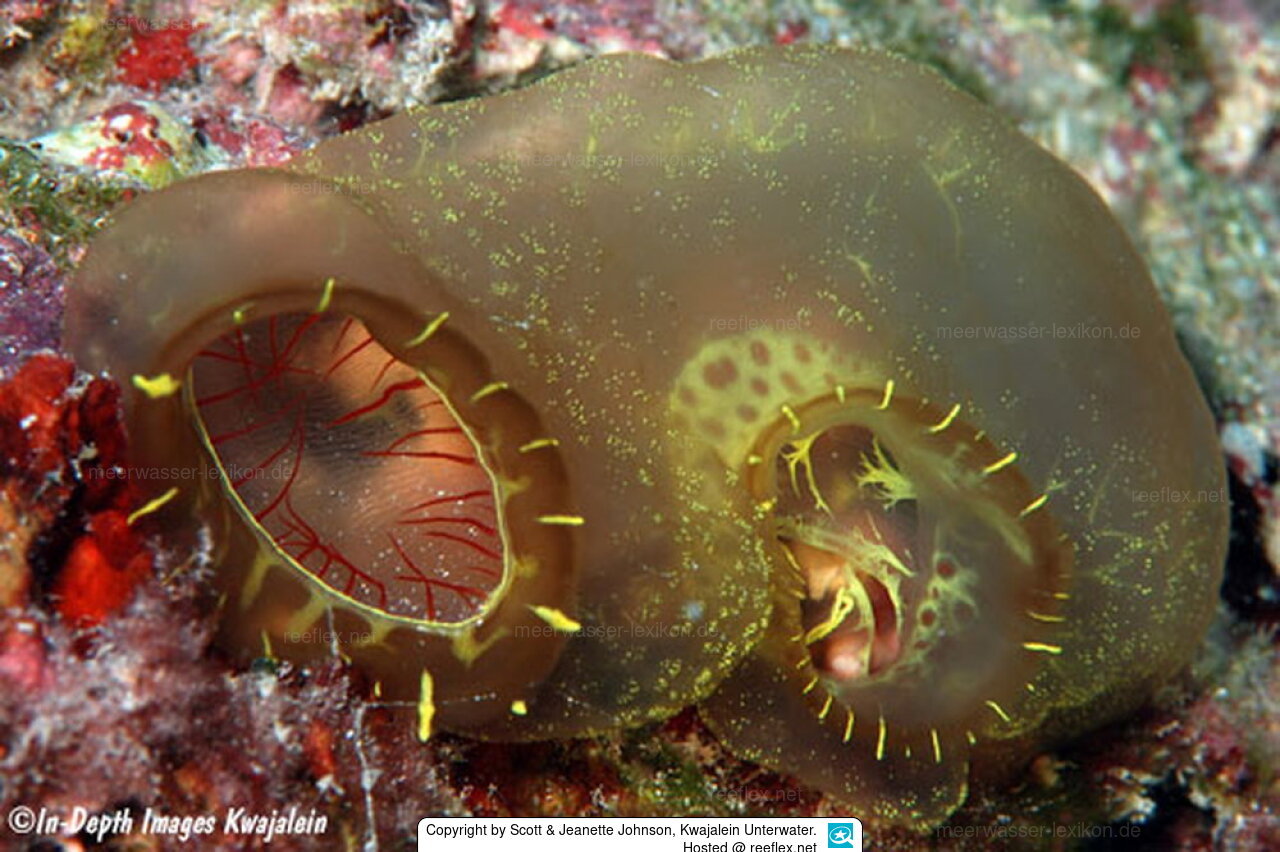Info
Ascidia ornata Monniot F. & Monniot C., 2001
Ascidia ornata is a rather large and solitary sea squirt. Its tunic is mammillate, transparent, and devoid of epibionts; it contains a network of dichotomously branching blood vessels that form small ampullae just beneath the surface of the tunic, but these are not reflected by papillae on the surface.
The siphons are widely spaced and slightly protruding. On the oral siphon are approximately round, non-toothed 20 lobes, to which a white pigment line gives a sharp appearance.
In both siphons the velum has a network of white pigment, the entire body wall is reddish, and the siphons and tentacles are most heavily colored. The oral siphon has a large, yellow colored opening surrounded by many short, white or yellow, tooth-like structures.
The cloacal siphon is smaller.
Ascidia ornata has about 30 long, cylindrical mouth tentacles that are irregularly arranged and red when alive. The tentacles are located on a ridge, in which some other very small tentacles are embedded.
The ascidian represents a round or elongated, gelatinous, humped mass, dotted with small white or golden dots. The translucent, slightly bluish to grayish tunic reveals many short, spine-like strokes or white lines of color. These lines may be latticed in the darker interior.
Ascidia ornata has often been the subject of scientific studies, but particularly revealing has been its partnership with marine symbiont bacteria (e.g., Bacillus cereus, Bacillus, megaterium, Bacillus pumilus. and others) whose extracts inhibit the human pathogenic microbe Staphyloccocus; these microbes are also resistant to conventional antibiotics.
Habitat: Ascidia ornata settles on hard substrate, so that often only the siphons are visible.
Etymology: The species name "ornatus" comes from Latin and means "ornamented".
Ascidia ornata is a rather large and solitary sea squirt. Its tunic is mammillate, transparent, and devoid of epibionts; it contains a network of dichotomously branching blood vessels that form small ampullae just beneath the surface of the tunic, but these are not reflected by papillae on the surface.
The siphons are widely spaced and slightly protruding. On the oral siphon are approximately round, non-toothed 20 lobes, to which a white pigment line gives a sharp appearance.
In both siphons the velum has a network of white pigment, the entire body wall is reddish, and the siphons and tentacles are most heavily colored. The oral siphon has a large, yellow colored opening surrounded by many short, white or yellow, tooth-like structures.
The cloacal siphon is smaller.
Ascidia ornata has about 30 long, cylindrical mouth tentacles that are irregularly arranged and red when alive. The tentacles are located on a ridge, in which some other very small tentacles are embedded.
The ascidian represents a round or elongated, gelatinous, humped mass, dotted with small white or golden dots. The translucent, slightly bluish to grayish tunic reveals many short, spine-like strokes or white lines of color. These lines may be latticed in the darker interior.
Ascidia ornata has often been the subject of scientific studies, but particularly revealing has been its partnership with marine symbiont bacteria (e.g., Bacillus cereus, Bacillus, megaterium, Bacillus pumilus. and others) whose extracts inhibit the human pathogenic microbe Staphyloccocus; these microbes are also resistant to conventional antibiotics.
Habitat: Ascidia ornata settles on hard substrate, so that often only the siphons are visible.
Etymology: The species name "ornatus" comes from Latin and means "ornamented".







 Scott & Jeanette Johnson, Kwajalein Unterwater
Scott & Jeanette Johnson, Kwajalein Unterwater










